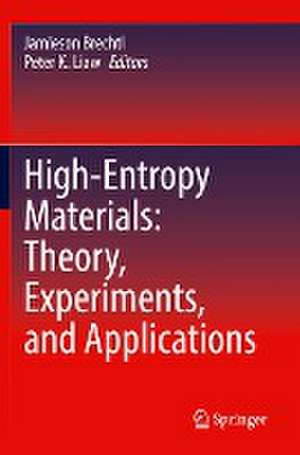High-Entropy Materials: Theory, Experiments, and Applications
Editat de Jamieson Brechtl, Peter K. Liawen Limba Engleză Paperback – 5 ian 2023
| Toate formatele și edițiile | Preț | Express |
|---|---|---|
| Paperback (1) | 516.44 lei 38-44 zile | |
| Springer International Publishing – 5 ian 2023 | 516.44 lei 38-44 zile | |
| Hardback (1) | 684.78 lei 38-44 zile | |
| Springer International Publishing – 4 ian 2022 | 684.78 lei 38-44 zile |
Preț: 516.44 lei
Preț vechi: 637.58 lei
-19% Nou
Puncte Express: 775
Preț estimativ în valută:
98.82€ • 107.68$ • 83.27£
98.82€ • 107.68$ • 83.27£
Carte tipărită la comandă
Livrare economică 19-25 aprilie
Preluare comenzi: 021 569.72.76
Specificații
ISBN-13: 9783030776435
ISBN-10: 3030776433
Pagini: 774
Ilustrații: VIII, 774 p. 45 illus.
Dimensiuni: 155 x 235 mm
Ediția:2021
Editura: Springer International Publishing
Colecția Springer
Locul publicării:Cham, Switzerland
ISBN-10: 3030776433
Pagini: 774
Ilustrații: VIII, 774 p. 45 illus.
Dimensiuni: 155 x 235 mm
Ediția:2021
Editura: Springer International Publishing
Colecția Springer
Locul publicării:Cham, Switzerland
Cuprins
Introduction.- Exotic Material Systems.- Unstable Plastic Dynamics and Serration Behavior.- Irradiation Materials Science.- Experimental Techniques.- Modeling and Analysis.- Irradiation Studies.- Conclusions.
Notă biografică
Dr. Jamieson Brechtl obtained his B.S. in Nuclear Engineering (with secondary majors in applied mathematics and physics) and his M.S. in Nuclear Engineering and Engineering Physics from the University of Wisconsin, Madison in 2012. He later obtained his Ph.D. in Energy Science and Engineering from the University of Tennessee, Knoxville in 2019. Currently, he works as a Postdoctoral Research Associate in the Multifunctional Equipment Integration Group at the Oak Ridge National Laboratory. His research interests include renewable energy, irradiation effects, plastic deformation, nanoindentation, X-ray and neutron diffraction, microscopy, ceramic and metallic powders, high-entropy alloys, bulk metallic glasses, data analysis, and applied mathematics. He has published over thirty journal papers and presented at numerous engineering conferences. In 2019, he was awarded the Chancellor’s Citation for Extraordinary Professional Promise from the University of Tennessee. He is also acurrent member of The Minerals, Metals and Materials Society (TMS).
Professor Liaw obtained his B.S. in Physics from the National Tsing Hua University, Taiwan, and his Ph.D. in Materials Science and Engineering from Northwestern University in 1980. After working at the Westinghouse Research and Development (R&D) Center for thirteen years, he joined the faculty and became an Endowed Ivan Racheff Chair of Excellence in the Department of Materials Science and Engineering at The University of Tennessee (UT), Knoxville in March 1993. He has worked in the areas of fatigue, fracture, nondestructive evaluation, and life-prediction methodologies of structural alloys and composites. Since joining UT, his research interests include mechanical behavior, neutron and synchrotron diffraction, bulk-metallic glasses, high-entropy alloys, and processing of high-temperature alloys and ceramic-matrix composites and coatings, with the kind help of his team members and colleagues at UT and Oak Ridge National Laboratory, and throughout the world. He has published over one thousand journal papers, edited and written fifty seven books and book chapters, and presented numerous plenary, keynote, and invited talks at various national and international conferences. He was awarded the Royal E. Cabell Fellowship at Northwestern University. He is the recipient of numerous “Outstanding Performance” awards from the Westinghouse R&D Center. He was the Chairman of The Minerals, Metals and Materials Society (TMS) “Mechanical Metallurgy” Committee, and Chairman of the American Society for Metals (ASM) “Flow and Fracture” Committee. He has been the Chairman and Member of the TMS Award Committee on “Application to Practice, Educator, and Leadership Awards.” He is a fellow of ASM and TMS. He has been given the Outstanding Teacher Award, the Moses E. and Mayme Brooks Distinguished Professor Award, the Engineering Research Fellow Awards, the National Alumni AssociationDistinguished Service Professor Award, the L. R. Hesler Award, and the John Fisher Professorship at UT, the TMS Distinguished Service Award, and a 2020 TMS Symposium dedicated to him. He has been the Director of the National Science Foundation (NSF) Integrative Graduate Education and Research Training (IGERT) Program, the Director of the NSF International Materials Institutes (IMI) Program, and the Director of the NSF Major Research Instrumentation (MRI) Program at UT. Several of his graduate students have been given awards for their research, papers, and presentations at various professional societies and conferences. Moreover, his students teach and conduct research at universities, industries, and government laboratories.
Textul de pe ultima copertă
This book discusses fundamental studies involving the history, modelling, simulation, experimental work, and applications on high-entropy materials. Topics include data-driven and machine-learning approaches, additive-manufacturing techniques, computational and analytical methods, such as density functional theory and multifractal analysis, mechanical behavior, high-throughput methods, and irradiation effects. The types of high-entropy materials consist of alloys, oxides, and ceramics. The book then concludes with a discussion on potential future applications of these novel materials.
- Includes both experimental and theoretical approaches for fundamental understanding of the behavior of high-entropy materials
- Discusses interesting and innovative approaches to studying various phenomena, such as machine learning, additive manufacturing, mechanical behavior, high-throughput techniques, and irradiation effects in high-entropy materials
- Facilitates the applications of high-entropy materials
- Provides an accessible reference for a broad audience of both academic, national laboratory, and industrial experts
Caracteristici
Includes both experimental and theoretical approaches for fundamental understanding of the behavior of high-entropy materials Facilitates the applications of high-entropy materials Provides an accessible reference for a broad audience of both academic, national laboratory, and industrial experts
